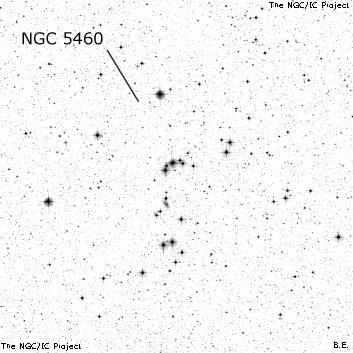NGC/IC Project Restoration Effort
(This is a very very beta version)
NGC5460


Basic Information
Location and Magnitude
Right Ascension: 14:7:36.0
Declination: -48:18:0
Constellation: CEN
Visual Magnitude: 5.6
Historic Information
Discoverer: Dunlop
Year of discovery: 1826
Discovery aperture: 9.0
Observational
Summary description: Cl, vL, vlC, st 8…
Sub-type: II3m
Corwin's Notes
=====
NGC 5460. JH saw this large cluster in three different sweeps; the positions
-- all a double star near the center of the cluster -- agree in two of these
(464 on 2 July 1834 and 695 on 20 April 1836). The other, however, is
approximately 30 seconds of time off (in Sweep 463 on 1 July 1834). JH
comments on this in a parenthetical note in Sweep 695: "N.B. The two double
stars taken in this and the foregoing observation [Sweep 463] are not the
same." The "two" double stars are in fact the same, and the RA is about 30
seconds of time too small in the first sweep.
Concerning the cluster itself, JH's descriptions are pretty accordant. He
makes it in Sweep 463 "A region of L, B sts 8,9 ... &c. m; a very coarse
cluster. Place that of a brilliant group, one of which is a double star class
III"; in Sweep 464 "Place of a double star (the same as that of Sweep 695) in
a semi-elliptic group forming part of it, but insulated in a large scattered
cluster or tract of bright stars"; and in Sweep 695 "A region of L stars very
loosely distributed, but which yet decidedly form a cluster. Place that of a
double star (4") in the middle of a group of 8. The cluster is 30' diameter,
and is divided into distinct groups."
The cluster's edges are difficult to define, but I would make it very roughly
26 arcmin by 23 arcmin, close enough to JH's estimate. I put the center about
five arcminutes southwest of his double star, but that, too, is very rough.
JH's "semi-elliptic group" is clearly seen near the center at 14 07 27,
-48 19.3 (J2000). He mentions this group in each of his descriptions of the
double star in the list of doubles in CGH -- it is indeed a striking group.
There is also a pretty low surface brightness galaxy seen through the cluster
at 14 07 35.18, -48 23 40.2 (J2000). This is ESO 221- G025 = PGC 050388, an
SB(s)d III, too small to be included in SGC.
The double star, by the way, is h4646 = h4647. JH's position for 4646 is
listed as "13 56 6+- 137 31+-" (1830) in the CGH double star list, in keeping
with his note "Place that of a brilliant group, one of which is a double star
class III". He gives the position angle as 125+- degrees ("Pos by estimation
of diagram"); there is no separation or magnitude listed. The PA for 4647 is
294.5 in Sweep 464 and 295.9 in Sweep 695, a 170 degree difference from the PA
of Sweep 463, clearly the same on the sky given the +- attached in the earlier
sweep. Separations are 5 and 4 arcseconds, and magnitudes are "9'=9'" and
"10=10", respectively. JH's positions given in the later two sweeps are the
same as given for the cluster.
Finally, the "class III" refers to WH's double star classes, explained in his
first paper "On the Parallax of the Fixed Stars" in PT 72, 82, 1782; this is
reprinted in the Scientific Papers in Vol. 1, page 39. The classes are based
on the distances between the stars, class III having separations of between 5
and 15 arcseconds. Classes I and II are closer without having their
separations exactly specified, while classes IV, V, and VI "... contain double
stars that are from 15 to 30[arcsec], from 30[arcsec] to 1[arcmin], and from
1[arcmin] to 2[arcmin] or more asunder."
Steve's Notes
=====
NGC 5460
22" (6/28/06 - Hawaii): this bright, very large cluster of ~120 stars extends to 30' at 110x. Many of the brighter stars are arranged in a very distinctive winding curve that snakes from NW to SE. At the center is a looping chain of eight mag 7 to 10 stars including a nice double h4647 = 9.3/9.6 at 11". At the NW and south ends are hooks of stars like the tail end of Scorpius. ESO 221-25, a faint galaxy, is hidden among the brighter stars and was not noticed.
13.1" (3/17/86): about three dozen stars, bright, large, includes several double stars. Appears scattered with stars arranged in distinct groups with a tight chain in center. Located 23' N of mag 6.4 HD 123247. This is one of the southernmost clusters visible from Northern California sites, but was still very pretty.



